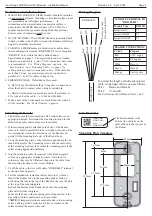
Inner Range SIFER Smart Card Reader. Installation Manual.
Revision 4.0 April. 2020.
V+
0V
A
B
Red
Black
White
Green
Orange
Factory use only
.
Not used in the field.
Preliminary Installation Notes
1. MOUNTING SURFACE. SIFER Readers should be installed
on non-metallic surfaces. Mounting on a metallic surface is not
recommended and will impair performance. In
circumstances where installation on a metallic surface is
unavoidable, the SIFER Reader Spacer (P/N: 999033) or
another non-metallic spacer/mounting block that provides
8mm or more of separation must be used.
2. IN/OUT READERS. If two SIFER Readers are installed back
to back on either side of a Door, mount the Readers at different
heights to minimize interference.
3. CABLING. SIFER Readers are wired in a star and/or daisy-
chain configuration from the ‘RDR RS485’ Port (or Inception
‘READER’ Port), within the limits defined under
Specifications on page 1. The pigtail cable can be extended
using twisted pair cable. 2-pair, 7/0.20 twisted pair data cable
is recommended.
See “Wiring Diagram” opposite.
See
“Specifications” and “Extending Cable” on page 1 for
cabling distances and recommended cables.
If the cable has
more than 2 Pairs, a spare pair may also be connected in
parallel to V+ & OV to reduce voltage drop.
4. SHIELDED CABLE. If shielded cable is used:
a) Do NOT use the shield as the 0V (negative) connection or
allow the shield to contact other wiring or metalwork.
b) Shield is terminated to a protective earth (if available) or
0V, at one end of the cable. i.e. At the host Module.
5. Make a note of the Serial number of each Reader & where it
will be installed.
See “Serial Number” opposite.
RDR RS485
Mounting Plate Template
20mm
10.5mm
8mm
30mm
65.5mm
91.5mm
27.5mm
38mm
To extend the length of the Reader pigtail
cable, twisted pair cable is used as follows:
Pair 1.
Data A and Data B
Pair 2.
V+ and 0V.
See Preliminary Installation Notes 3 & 4.
D
I
L
A
N
I
M
R
E
T
E
L
U
D
O
M
"
5
8
4
S
R
R
D
R
"
e
p
y
T
e
l
u
d
o
M
D
I
B
C
P
C
A
I
i
t
i
r
g
e
t
n
I
7
T
M
A
L
I
i
t
i
r
g
e
t
n
I
1
T
M
A
L
S
i
t
i
r
g
e
t
n
I
1
T
S
N
O
I
T
C
E
N
N
O
C
R
E
D
A
E
R
r
u
o
l
o
C
e
s
o
p
r
u
P
d
e
R
y
l
p
p
u
s
V
2
1
+
k
c
a
l
B
y
l
p
p
u
s
V
0
e
t
i
h
W
A
a
t
a
D
n
e
e
r
G
B
a
t
a
D
e
g
n
a
r
O
y
l
n
o
y
r
o
t
c
a
F
Reader Cable.
Installing the Reader
1. The Reader should be mounted on a flat, solid surface at an
appropriate height. Determine the mounting location for the
Reader and ensure that cable access is available.
2. If the mounting plate is attached to the body of the Reader,
remove it. Insert a small flat blade screwdriver into one of the
two rectangular slots at the bottom rear of the Reader and
gently lift the mounting plate out of the Reader body.
3. Using the mounting plate, or the template opposite, mark out,
then drill holes for the 2 mounting screws and the cable entry
at the mounting location, then secure the mounting plate to the
surface using appropriate hardware.
4. Join the extending cable (if required) to the Reader pigtail
cable using appropriate terminals/joiners. Note the wire
colours (as they may be different), then route the cable from
the mounting location to the Access Module.
5. Fit off the cable to the Access Module “RDR RS485” terminal
as shown above opposite.
6. Test the installation, including tamper detection
*
(if used),
then fit the Reader body to the mounting plate as follows:
a)
Position the tabs in the top of the Reader body into the slots
at the top of the mounting plate.
b)
Push the bottom of the Reader body onto the mounting
plate until it clicks into place.
c)
Secure the body to the mounting plate at the bottom of the
assembly with the countersunk screw provided.
*NOTE:
If tamper detection is unreliable due to the mounting
surface, adding a white/reflective sticker, or similar, on the
surface behind the sensor will assist.
Page 2
Wiring Diagram
Serial Number
The Serial number is the
bottom line of digits on the
label affixed to the top rear of
the Reader.
964720-
220714-
00-
000297




















